WordPress模板制作其实非常简单,今天蜗牛博客就带你从零开始制作一个Wordpress模板,只需要花半天的时间,你也可以制作一个你心中理想的Wordpress模板。
比如,想做一下下面这样的模板。

一、素材
1.下载模板
我们直接以仿站开始吧,首先找到一个你喜欢的网站,比如:http://demo.codethemes.co/robolist-pro/,
然后用仿站工具,将这个网站的模板下载下来。一般我们只需要首页、列表页、详情页三个页面就可以了。
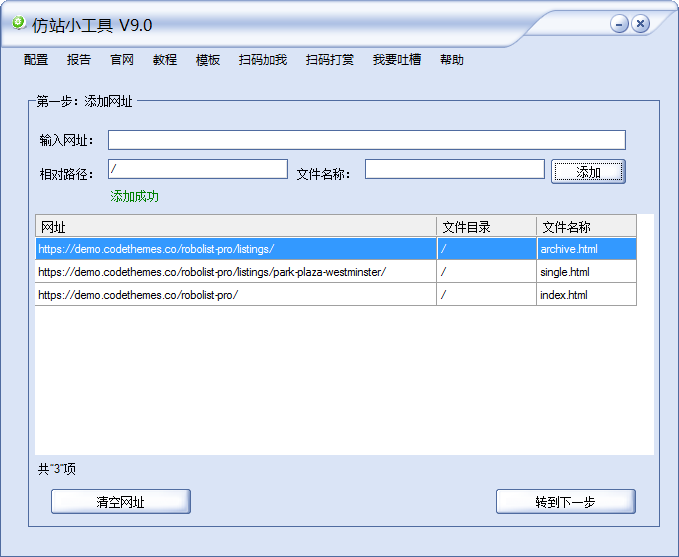
其中的:
index.html wordrpess首页
archive.html wordpress的列表页
single.html wordpressrr的文章详情页。
下载后保存到电脑是这样的:
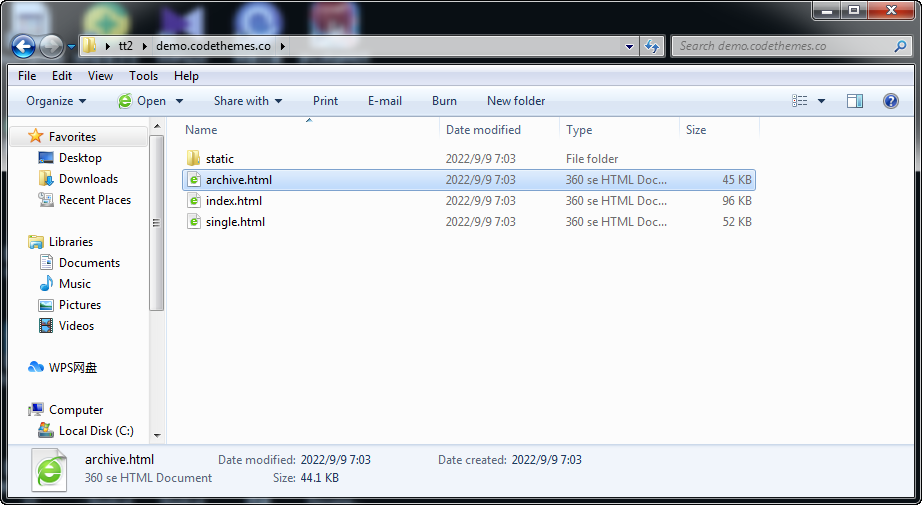
2.整理模板
用notepad或者sublime之类的软件打开模板文件看一下它的代码,如果比较整齐则不用这一步。
如果下载的模板排板上有点乱,需要用html格式化工具进行一些整理,比较好用的有:
http://web.chacuo.net/formathtml/(暂时觉得这个最好用)
https://www.sojson.com/jshtml.html
二、后台显示模板
1.建立模板文件夹
在wordpress后台的theme下面建立一个文件夹Stheme,用来存放你的模板,并将你下载的模板放到这个文件夹下面。
2. index.php
将index.html改成php文件index.php。
3.style.css
因为我们在第一步下载别人网站的模板的时候,设定了将所有的css文件放到了css文件夹下面,所以style.css也当然存到了css文件夹下面。不过在wordpress的模板中,style.css必须保存在模板的根目录下面,所以我们这里需要将style.css从css文件夹下面移到模板的根目录Stheme下面,即和index.php同一个目录下面。
修改style.css文件,将以下代码放到style.css文件中
/* Theme Name: Stheme Author: 蜗牛博客 Author URI: http://www.snailtoday.com Description: 图片展示主题 Version: 1.0 */
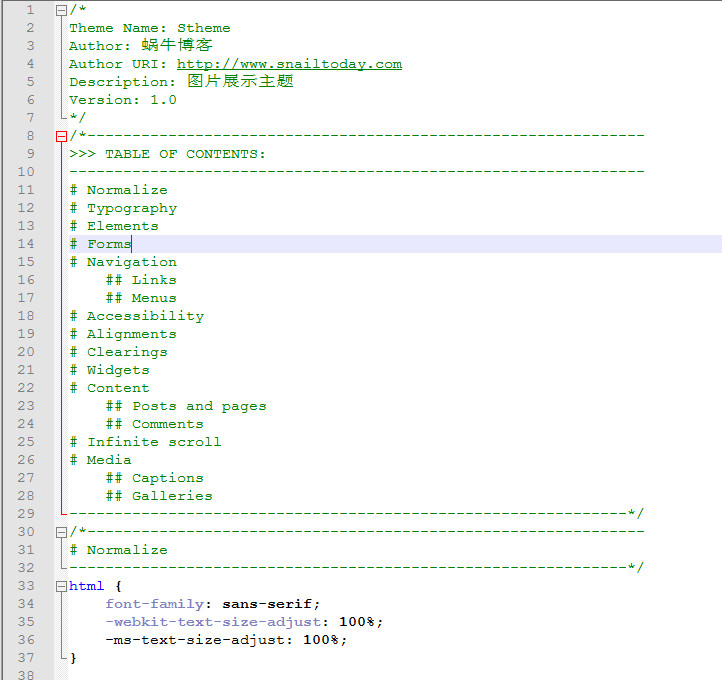
4.查看效果
这时登陆后台,可以看到我们的模板已经在后台显示了。不过没有缩略图。
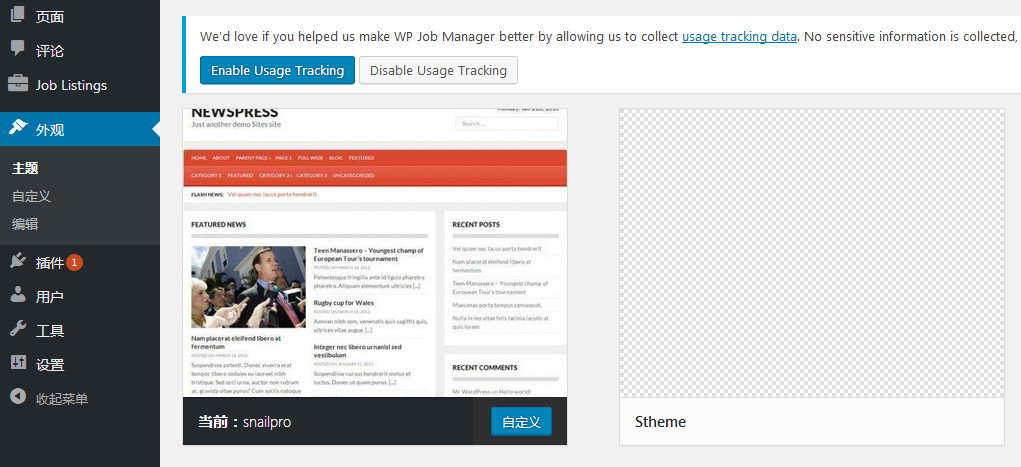
5.缩略图
在根目录Stheme下面放上一张图片,命名为screenshot.png(或者jpg),然后就可以看到效果了。
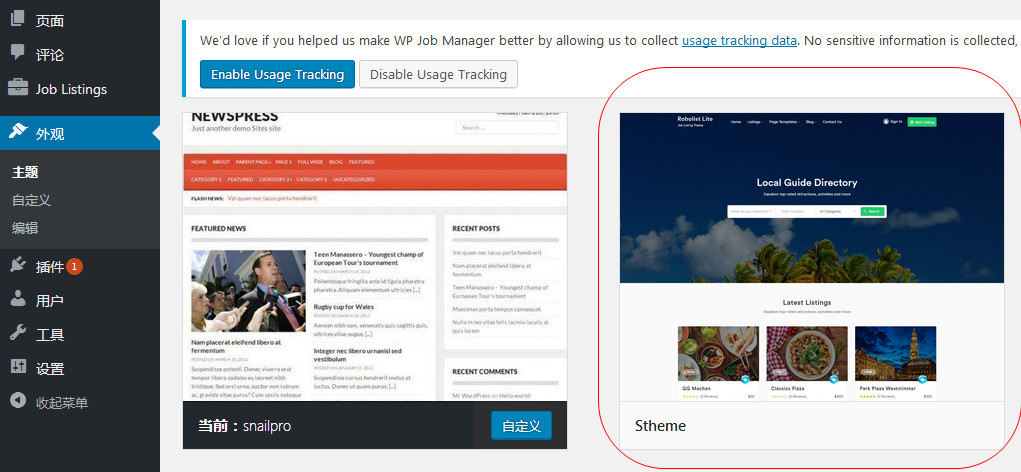
6、启用模板
在wordpress后台启用我们制作的模板,不过发现CSS是乱的。
三、修改style.css
修改style.css文件中的css、js、images文件的路径,直接用替换功能即可。比如:
/static/js/ #替换成 <?php echo get_template_directory_uri(); ?>/static/js/
关于wordpress的函数,可以看这里:https://developer.wordpress.org/reference/since/5.1.0/
这时再看首页,就发现和目标站一模一样了。

四、首页title
1.在模板根目录新建一个functions.php文件。
2.加入以下代码,用于首页显示站点信息等。
<?php
add_filter('wp_title', 'lingfeng_wp_title', 10, 2);
function lingfeng_wp_title($title, $sep) {
global $paged, $page;
//如果是feed页,返回默认标题内容
if ( is_feed() ) {
return $title;
}
// 标题中追加站点标题
$title .= get_bloginfo( 'name' );
// 网站首页追加站点副标题
$site_description = get_bloginfo( 'description', 'display' );
if ( $site_description && ( is_home() || is_front_page() ) )
$title = "$title $sep $site_description";
// 标题中显示第几页
if ( $paged >= 2 || $page >= 2 )
$title = "$title $sep " . sprintf( '第%s页', max( $paged, $page ) );
//去除空格,-的字符实体
$search = array('–', ' ');
$replace = array('-', '');
$title = str_replace($search, $replace, $title);
return $title;
}
?>
3.在title的位置添加以下代码:
<?php wp_title('|',true,'right'); ?>
4.效果预览
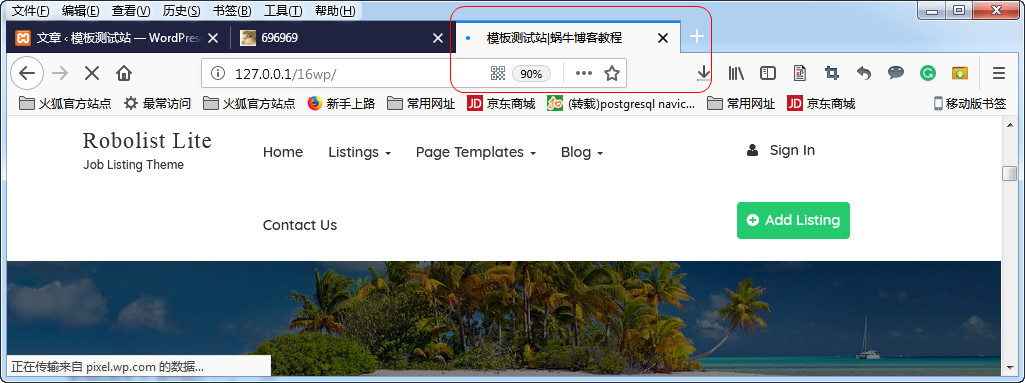
如果想在在不同的页面类型中显示不同的title
<?php
if (is_home() ) {bloginfo('name');echo " - ";
bloginfo('description');} elseif ( is_category() ) {single_cat_title();
echo " - "; bloginfo('name');} elseif (is_single() || is_page() )
{single_post_title(); echo " - "; bloginfo('name');} elseif (is_search()
) {echo "搜索结果"; echo " - "; bloginfo('name');} elseif (is_404() ) {echo
'页面未找到!';} else {wp_title('',true);}
?>
五、站点标题、副标题
代码:
<?php bloginfo('name'); ?> #标题
<?php bloginfo('description'); ?> #副标题
<?php bloginfo('url'); ?> #设定站点标题的链接到首页。
效果预览:

六、search form
在相应位置直接用以下代码:
<?php get_search_form(); ?>
如果模板文件下面没有searchform.php文件,则wordpress调用默认的表单。
如果有,则将searchform.php文件显示在搜索表单的位置。
修改搜索框的样式:
可以自己设计一个函数,持到get_search_form这个函数上面。
function my_search_form( $form ) {
$form = '<form role="search" method="get" id="searchform" action="' . home_url( '/' ) . '" >
<div><label class="screen-reader-text" for="s">' . __('Search for:') . '</label>
<input type="text" value="' . get_search_query() . '" name="s" id="s" />
<input type="submit" id="searchsubmit" value="'. esc_attr__('Search') .'" />
</div>
</form>';
return $form;
}
add_filter( 'get_search_form', 'my_search_form' );
经测试这种方法还没有过时,可以参考:https://ninghao.net/video/703
七、首页文章
1.删除多余的代码,只留下第一行的第一张图片。
2.主循环
代码:
<?php if( have_posts() ) : while( have_posts() ) : the_post(); ?> <!-- 在这里调用数据 --> <?php endwhile; ?> <?php endif; ?>
效果:
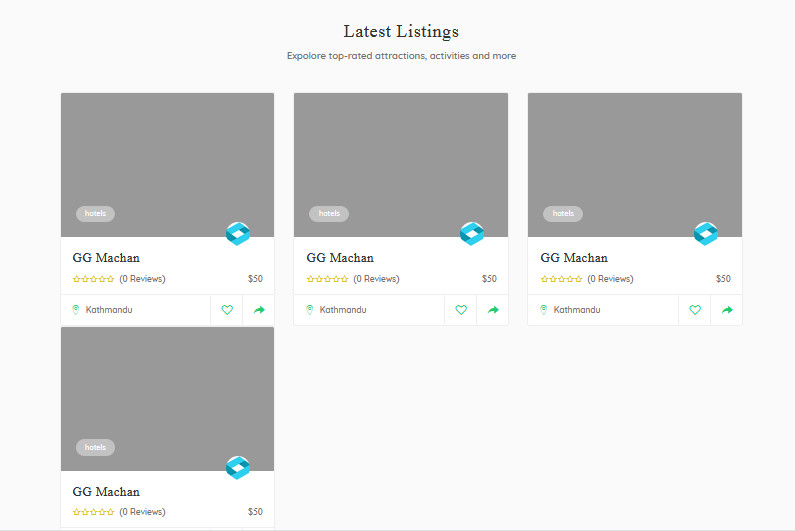
3.显示文章标题、缩略图
缩略图代码在这里。
<?php the_title(); ?> #显示文章标题
<?php the_permalink(); ?> #文章的网址
<?php echo get_content_first_image(get_the_content()); ?> #缩略图地
<?php the_content(); ?> #显示文章内容
<?php the_category('.'); ?> #显示文章分类
<?php the_time('Y年m月d日 H:i:s'); ?> #显示发布时间
<?php comments_popup_link('0','1','%');?> #显示评论的条目
<?php the_tags('<strong>标签:</strong> ', ' , ' , ''); ?> #显示文章标签
标签可以参考:http://www.1mayi.com/1224.html
另外,这套模板有个问题,如果某文章的标题太长,则排版会乱掉。所以需要对文章标题进行截取处理,代码如下:
<?php $title = get_the_title(); $trimmed_title = wp_trim_words( $title, 20, '...' ); echo $trimmed_title; ?>
上面的是按字数来显示,如果是英文是按单词数来显示,如果要按英文字母的长度来显示,就用下面这个:
<?php echo mb_strimwidth(get_the_title(), 0, 20, '...'); ?>
参考:https://stackoverflow.com/questions/24636136/how-do-i-show-when-the-wordpress-title-exceeds-length
woocommerce产品列表中标题长度的修改方法:
在function.php中加入以下代码
add_filter( 'the_title', 'shorten_woo_product_title', 10, 2 );
function shorten_woo_product_title( $title, $id ) {
if ( ! is_singular( array( 'product' ) ) && get_post_type( $id ) === 'product' ) {
return substr( $title, 0, 45); // change last number to the number of characters you want
} else {
return $title;
}
}
4.显示文章内容
<?php echo wp_trim_words( get_the_title(),50);// 截取50字的文章标题 echo wp_trim_words( get_the_excerpt(),100);// 截取100字的文章摘要 echo wp_trim_words( get_the_content(),500);// 截取500字的文章内容 ?>
自编代码:
<?php the_content(); ?> #显示文章内容 <?php echo lingfeng_strimwidth(get_the_content(),190); ?> #截取190个字符。
但是p元素会换行。
截取字符串的长度:
function lingfeng_strimwidth( $str, $len, $start = 0, $suffix = '……' ) {
$str = str_replace(array(' ', ' ',' ', '\r\n'), '', strip_tags( $str ));
if ( $len>mb_strlen( $str ) ) {
return mb_substr( $str, $start, $len );
}
return mb_substr($str, $start, $len) . $suffix;
}
5.文章浏览次数
Updated on 2021:
这个最好用WP-PostViews插件,这样可以轻松实现“浏览次数最多的10篇文章这样的功能。”
/**
* getPostViews()函数
* 功能:获取阅读数量
*/
function getPostViews( $postID ) {
$count_key = 'post_views_count';
$count = get_post_meta( $postID, $count_key, true );
if( $count=='' ) {
delete_post_meta( $postID, $count_key );
add_post_meta( $postID, $count_key, '0' );
return "0";
}
return $count;
}
/**
* setPostViews()函数
* 功能:设置或更新阅读数量
*/
function setPostViews( $postID ) {
$count_key = 'post_views_count';
$count = get_post_meta( $postID, $count_key, true );
if( $count=='' ) {
$count = 0;
delete_post_meta( $postID, $count_key );
add_post_meta( $postID, $count_key, '0' );
} else {
$count++;
update_post_meta( $postID, $count_key, $count );
}
}
显示文章浏览次数。
<?php setPostViews(get_the_ID()); ?> #这行代码也不能少 <?php echo getPostViews(get_the_ID()); ?>
6.显示标签
the_tags的三个参数,前后是前后显示的字符,中间是分隔符号。
<?php if(has_tag()):?>
<?php the_tags('',',','');?>
<?php else; ?>
暂无
<?php endif; ?>
7.文章分页
分页函数,注意:如果显示的间隔太短,可以直接用空格来填充。
/**
* 数字分页函数
* 因为wordpress默认仅仅提供简单分页
* 所以要实现数字分页,需要自定义函数
* @Param int $range 数字分页的宽度
* @Return string|empty 输出分页的HTML代码
*/
function lingfeng_pagenavi( $range = 4 ) {
global $paged,$wp_query;
if ( !$max_page ) {
$max_page = $wp_query->max_num_pages;
}
if( $max_page >1 ) {
echo "<div class='fenye'>";
if( !$paged ){
$paged = 1;
}
if( $paged != 1 ) {
echo "<a href='".get_pagenum_link(1) ."' class='extend' title='跳转到首页'>首页 </a>";
}
previous_posts_link('上一页 ');
if ( $max_page >$range ) {
if( $paged <$range ) {
for( $i = 1; $i <= ($range +1); $i++ ) {
echo "<a href='".get_pagenum_link($i) ."'";
if($i==$paged) echo " class='current'";echo ">$i </a>";
}
}elseif($paged >= ($max_page -ceil(($range/2)))){
for($i = $max_page -$range;$i <= $max_page;$i++){
echo "<a href='".get_pagenum_link($i) ."'";
if($i==$paged)echo " class='current'";echo ">$i</a>";
}
}elseif($paged >= $range &&$paged <($max_page -ceil(($range/2)))){
for($i = ($paged -ceil($range/2));$i <= ($paged +ceil(($range/2)));$i++){
echo "<a href='".get_pagenum_link($i) ."'";if($i==$paged) echo " class='current'";echo ">$i</a>";
}
}
}else{
for($i = 1;$i <= $max_page;$i++){
echo "<a href='".get_pagenum_link($i) ."'";
if($i==$paged)echo " class='current'";echo ">$i</a>";
}
}
next_posts_link('下一页 ');
if($paged != $max_page){
echo "<a href='".get_pagenum_link($max_page) ."' class='extend' title='跳转到最后一页'>尾页</a>";
}
echo '<span>共['.$max_page.']页</span>';
echo "</div>\n";
}
}
在engif之前调用。
<?php endwhile; ?> <?php lingfeng_pagenavi(); ?> <?php endif; ?>
备注:
如果加入代码没有显示,可能你的文章数量太少了,需要在WordPress后台【常规】→【阅读】选项中,将“博客页面至多显示XX篇文章”设置为1,然后即可看到分页。
样式
/*------------------
分页部分的CSS
------------------*/
.fenye{
height: 25px;
line-height: 25px;
_background: #F9F9F9;
padding: 2px 5px;
margin: 20px 4px;
_border: solid 1px #ccc;
_text-align: center;
}
.fenye a{
padding:4px 6px 4px 6px;
margin:0 2px 0 2px;
border:1px solid #aaa;
text-decoration:none;
color:#333;
}
.fenye a.current{
background:#ff6f3d;
color:#fff;
}
.fenye a:hover{
background:#ff6f3d;
color:#fff;
}
另外,还可以使用分页插件。
bootstrap分页
function snail_paging() {
$p = 3;
if ( is_singular() ) return;
global $wp_query, $paged;
$max_page = $wp_query->max_num_pages;
if ( $max_page == 1 ) return;
echo '<ul class="pagination">';
if ( empty( $paged ) ) $paged = 1;
// echo '<span class="pages">Page: ' . $paged . ' of ' . $max_page . ' </span> ';
if ( $paged > 1 ) p_link( 1, '首页' );
echo '<li class="prev-page">'; previous_posts_link('上一页'); echo '</li>';
//if ( $paged > $p + 1 ) p_link( 1 );
//if ( $paged > $p + 2 ) echo "<li><span>···</span></li>";
for( $i = $paged - $p; $i <= $paged + $p; $i++ ) {
if ( $i > 0 && $i <= $max_page ) $i == $paged ? print "<li class=\"active\"><span>{$i}</span></li>" : p_link( $i );
}
//if ( $paged < $max_page - $p - 1 ) echo "<li><span> ... </span></li>";
//if ( $paged < $max_page - $p ) p_link( $max_page);
echo '<li class="next-page">'; next_posts_link('下一页'); echo '</li>';
p_link( $max_page, '尾页' );
//echo '<li><span>共 '.$max_page.' 页</span></li>';
echo '</ul>';
}
function p_link( $i, $title = '' ) {
if ( $title == '' ) $title = "{$i}";
echo "<li><a href='", esc_html( get_pagenum_link( $i ) ), "'>{$title}</a></li>";
}
function p_curr_link( $i) {
echo '<li><span class="active">'.$i.'</span></li>';
}
八、文章分类页
分类页的模板名为archive.php,因为一般分类页也是文章列表,参照首页做就可以了。
就用:
<?php if( have_posts() ) : while( have_posts() ) : the_post(); ?> <!-- 在这里调用数据 --> <?php endwhile; ?> <?php endif; ?>
页面显示分类的名称:
<?php $thiscat = get_category($cat); echo $thiscat ->name;?>
代码二
<?php
foreach((get_the_category()) as $category)
{
echo $category->cat_name;
}
?>
参考:https://www.admin122.com/blog/3432.html
九、实现相关文章的方法
代码测试可用
<ul id="cat_related">
<?php
global $post;
$cats = wp_get_post_categories($post->ID);
if ($cats) {
$args = array(
'category__in' => array( $cats[0] ),
'post__not_in' => array( $post->ID ),
'showposts' => 6,
'caller_get_posts' => 1
);
query_posts($args);
if (have_posts()) :
while (have_posts()) : the_post(); update_post_caches($posts); ?>
<li>* <a href="<?php the_permalink(); ?>" rel="bookmark" title="<?php the_title_attribute(); ?>"><?php the_title(); ?></a></li>
<?php endwhile; else : ?>
<li>* 暂无相关文章</li>
<?php endif; wp_reset_query(); } ?>
</ul>
2.根据标签查找相关文章,并显示文章摘要
<ul id="tags_related">
<?php
global $post;
$post_tags = wp_get_post_tags($post->ID);
if ($post_tags) {
foreach ($post_tags as $tag)
{
// 获取标签列表
$tag_list[] .= $tag->term_id;
}
// 随机获取标签列表中的一个标签
$post_tag = $tag_list[ mt_rand(0, count($tag_list) - 1) ];
// 该方法使用 query_posts() 函数来调用相关文章,以下是参数列表
$args = array(
'tag__in' => array($post_tag),
'category__not_in' => array(NULL), // 不包括的分类ID
'post__not_in' => array($post->ID),
'showposts' => 20, // 显示相关文章数量
'caller_get_posts' => 1
);
query_posts($args);
if (have_posts()) :
while (have_posts()) : the_post(); update_post_caches($posts); ?>
<li>* <a href="<?php the_permalink(); ?>" rel="bookmark" title="<?php the_title_attribute(); ?>"><?php the_title(); ?></a></li>
<p style="color: rgba(0, 0, 0, 0.32);margin-bottom: 8px;">
<?php echo wp_trim_words( get_the_content(),160);?>
</p>
<?php endwhile; else : ?>
<li>* 暂无相关文章</li>
<?php endif; wp_reset_query(); } ?>
</ul>
参考:https://blog.csdn.net/weixin_33834910/article/details/91869215
十、首页显示最新的文件及缩略图
最简单的代码
<?php get_archives("postbypost", 10); ?>
代码二:
<?php query_posts("showposts=3&cat=1")?>
<?php while (have_posts()) : the_post(); ?>
<?php if ( get_post_meta($post->ID, ‘pre_image’, true) ) : ?>
<?php $image = get_post_meta($post->ID, ‘pre_image’, true); ?>
<a href=”<?php the_permalink() ?>”><img alt=”<?php the_title(); ?>” src=”<?php echo $image; ?>”></a>
<?php else: ?>
<a href=”<?php the_permalink() ?>”><img alt=”<?php the_title(); ?>” src=”<?php bloginfo(‘template_url’); ?>/files/wp30a.png”></a>
<?php endif; ?>
<h3><a title=”#” href=”<?php the_permalink() ?>”><?php the_title(); ?></a></h3>
<p><?php the_excerpt(); ?>…</p>
<?php endwhile; ?>
简化版本:
不过这个有时和文章详情页的代码有冲突,会导致文章详情页显示多篇文章的内容。
<?php query_posts("showposts=3&cat=1")?>
<?php while (have_posts()): the_post(); ?>
<h3><a title="#"" href="<?php the_permalink() ?>"><?php the_title(); ?></a></h3>
<?php endwhile; ?>
进一步阅读:
4小时学会WordPress模板制作(二)
4小时学会WordPress模板制作(三)
4小时学会WordPress模板制作(四)常用代码
参考:
https://blog.csdn.net/cloudday/article/details/7276330
另外,发现没有设定文章的摘要,使用the_excerpt()也可以取到值,查了一下,原来:
如果在文章中没有编辑内容摘要字段,则默认截取文章的前55个字的内容
参考:http://www.xuxiaoke.com/wpfunc/131.html

